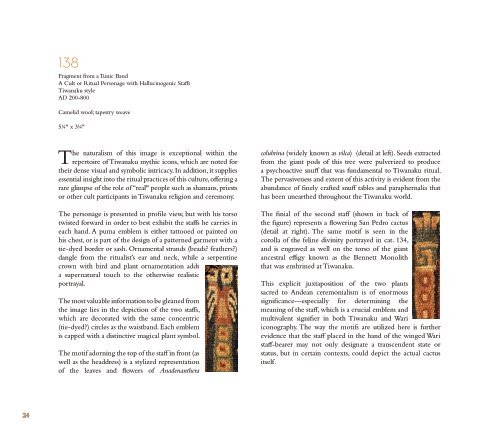You also want an ePaper? Increase the reach of your titles
YUMPU automatically turns print PDFs into web optimized ePapers that Google loves.
138<br />
Fragment from a Tunic Band<br />
A Cult or Ritual Personage with Hallucinogenic Staffs<br />
Tiwanaku style<br />
AD 200-800<br />
Camelid wool; tapestry weave<br />
5¼" x 3¼"<br />
The naturalism of this image is exceptional within <strong>the</strong><br />
repertoire of Tiwanaku mythic icons, which are noted for<br />
<strong>the</strong>ir dense visual and symbolic intricacy. In addition, it supplies<br />
essential insight into <strong>the</strong> ritual practices of this culture, offering a<br />
rare glimpse of <strong>the</strong> role of “real" people such as shamans, priests<br />
or o<strong>the</strong>r cult participants in Tiwanaku religion and ceremony.<br />
The personage is presented in profile view, but with his torso<br />
twisted forward in order to best exhibit <strong>the</strong> staffs he carries in<br />
each hand. A puma emblem is ei<strong>the</strong>r tattooed or painted on<br />
his chest, or is part of <strong>the</strong> design of a patterned garment with a<br />
tie-dyed border or sash. Ornamental strands (beads? fea<strong>the</strong>rs?)<br />
dangle from <strong>the</strong> ritualist’s ear and neck, while a serpentine<br />
crown with bird and plant ornamentation adds<br />
a supernatural touch to <strong>the</strong> o<strong>the</strong>rwise realistic<br />
portrayal.<br />
The most valuable information to be gleaned from<br />
<strong>the</strong> image lies in <strong>the</strong> depiction of <strong>the</strong> two staffs,<br />
which are decorated with <strong>the</strong> same concentric<br />
(tie-dyed?) circles as <strong>the</strong> waistband. Each emblem<br />
is capped with a distinctive magical plant symbol.<br />
The motif adorning <strong>the</strong> top of <strong>the</strong> staff in front (as<br />
well as <strong>the</strong> headdress) is a stylized representation<br />
of <strong>the</strong> leaves and flowers of Anadenan<strong>the</strong>ra<br />
colubrina (widely known as vilca) (detail at left). Seeds extracted<br />
from <strong>the</strong> giant pods of this tree were pulverized to produce<br />
a psychoactive snuff that was fundamental to Tiwanaku ritual.<br />
The pervasiveness and extent of this activity is evident from <strong>the</strong><br />
abundance of finely crafted snuff tables and paraphernalia that<br />
has been unear<strong>the</strong>d throughout <strong>the</strong> Tiwanaku world.<br />
The finial of <strong>the</strong> second staff (shown in back of<br />
<strong>the</strong> figure) represents a flowering San Pedro cactus<br />
(detail at right). The same motif is seen in <strong>the</strong><br />
corolla of <strong>the</strong> feline divinity portrayed in cat. 134,<br />
and is engraved as well on <strong>the</strong> torso of <strong>the</strong> giant<br />
ancestral effigy known as <strong>the</strong> Bennett Monolith<br />
that was enshrined at Tiwanaku.<br />
This explicit juxtaposition of <strong>the</strong> two plants<br />
sacred to Andean ceremonialism is of enormous<br />
significance—especially for determining <strong>the</strong><br />
meaning of <strong>the</strong> staff, which is a crucial emblem and<br />
multivalent signifier in both Tiwanaku and Wari<br />
iconography. The way <strong>the</strong> motifs are utilized here is fur<strong>the</strong>r<br />
evidence that <strong>the</strong> staff placed in <strong>the</strong> hand of <strong>the</strong> winged Wari<br />
staff-bearer may not only designate a transcendent state or<br />
status, but in certain contexts, could depict <strong>the</strong> actual cactus<br />
itself.<br />
24







